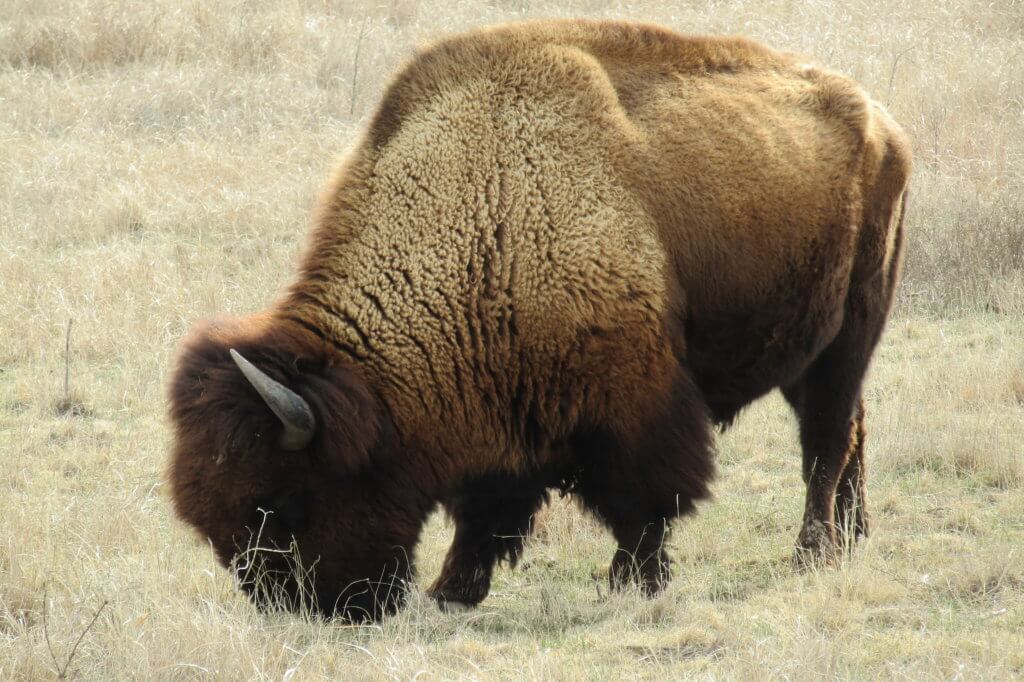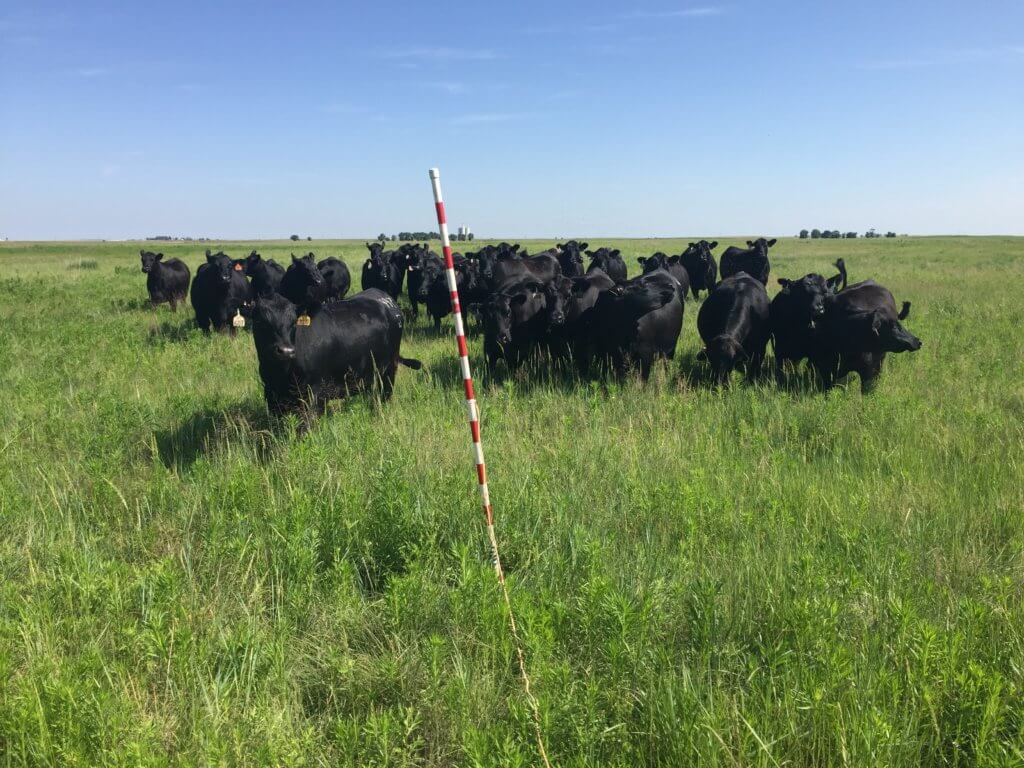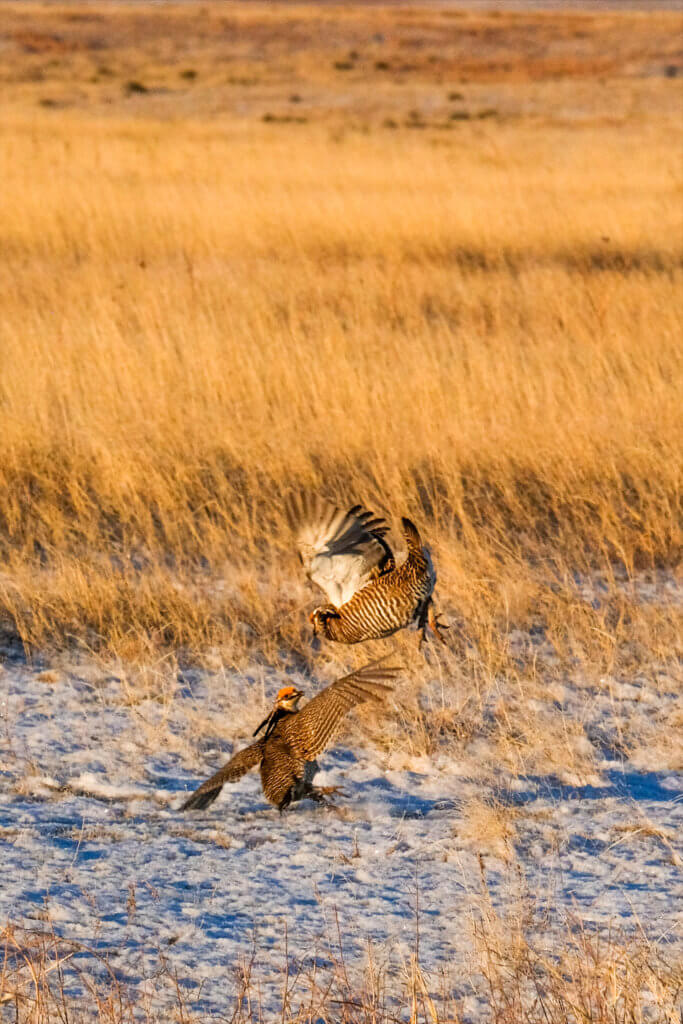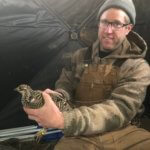GROUSE, GRASS AND GARGANTUAN FIRE
MEGAFIRE MAY BE A NEW THREAT TO IMPERILED LESSER-PRAIRIE CHICKEN
BY NICHOLAS PARKER AND DANIEL SULLINS

PHOTO BY ELLEN WHITTLE.
Spring mornings in southwestern Kansas often begin cool, dark, and quiet. Among the surrounding silence, the prairie slowly awakens. Sometime after the owls stop asking “who?” and before the liquid summer song of the meadowlark bubbles forth to greet the light, you hear lesser prairie-chickens; they yodel, boom, gobble, gurgle, moan, whine, cluck, and cackle, filling the cool spring dark with life.
The morning of March 6, 2017, in Clark County, dawned with the prairie muffled by a strong sustained south wind, bringing with it faint whiffs of smoke. The next morning the prairie was utterly dark and quiet, with charred and blackened ground for miles around.
The wind-driven Starbuck fire burned more than 250,000 hectares in Kansas and Oklahoma on March 6 and 7, breaking the record of largest wildfire in Kansas. The record had been set just the previous year, in 2016, by the 150,000-hectare Anderson Creek fire. Both wildfires were known as megafires for their massive size (> 40,000 hectares, or 100,000 acres) and lasting impacts to the rural communities affected. Separated by a year and roughly 50 miles, both megafires burned the sparsely populated Red Hills region of Kansas, an area of rolling grasslands dedicated to agriculture and cattle ranching. The Starbuck fire killed between 5,000 and 9,000 cattle and caused an estimated $44 million in damage to fences and structures alone.
In addition to megafire impacts to rural communities in these areas, both megafires burned grasslands occupied by lesser prairie-chickens. The lesser prairie-chicken (Tympanuchus pallidicinctus) is a dull, brownish, football sized grouse found in the southern Great Plains of North America. While quiet and unnoticed for most of the year, in the spring male lesser prairie-chickens are scintillating stars of the prairie. They gather on communal mating grounds known as leks to sing, dance, and display for females. Males stamp their feet, inflate bright red air sacks on their necks, fan out brilliantly yellow eyebrows, and gobble, cackle, and yodel to woo females. Female prairie-chickens remain quiet and cryptic, hesitantly darting around the leks, seemingly unimpressed by the strutting and dancing of puffed-up males. The age-old ritual repeats every spring, with lesser prairie-chickens returning to the same leks year after year, with some leks existing in the same spots for greater than 40 years.
Unfortunately, much like the North American prairie, once abundant lesser prairie-chicken populations have dwindled. Historical accounts speculated that millions of lesser prairie-chickens may have been on the prairie prior to 1900, and surveys that began in the 1960s estimated an overall population of around 175,000 individuals. Today, estimates suggest there are only around 30,000 individuals. Concern over reduced populations led to the lesser prairie-chicken being listed as threatened under the Endangered Species Act in 2014, but legal issues led to its delisting in 2016. In 2021, the US Fish and Wildlife service once again proposed to list the species, this time as threatened in the northern part of their range and endangered in the south. Lesser prairie-chicken declines are linked to loss of habitat, as native prairies throughout their range have been lost to farming, energy exploration (oil and gas wells, wind turbines), and other human activity. Many remaining grasslands have been further altered and degraded due to mismanaged grazing and the expansion of invasive trees.
The increase in megafires throughout the lesser prairie-chicken range poses yet another potential threat to the already declining species. Although prairie-chickens are adept at avoiding small fires, many may be killed in the path of fast moving and intense megafires. Following large megafires, hundreds of thousands of acres of grasslands are lost or altered, and lesser prairie-chickens may have few places to go, as they are already restricted to increasingly fragmented islands of intact grasslands.
Ironically, it was likely the removal of fire from grassland ecosystems that paved the way for record fire years in the southern Great Plains in 2016 and 2017. Fire was historically an essential part of grassland ecosystems as fires kept prairies as prairies, killing trees and structuring grasslands. These fires were sometimes naturally caused, but often were ignited by Indigenous peoples. This practice ended following European settlement, and fire has largely been suppressed and removed from Great Plains grasslands. Fire suppression has led to increased trees and grassland areas thick with dead vegetation and litter that provided the fuel for these blazes. When combined with changing climates and extreme droughts, much of the southern Great Plains is at high risk of extreme wildfires.


Unfortunately, it is only predicted to get worse. Trees are increasing exponentially, and climate predictions suggest increased occurrence of hotter and drier years that will promote larger, more frequent wildfires. The same factors leading to increased wildfire risk have degraded grassland quality and decreased lesser prairie-chicken habitat and populations. When such factors culminate in a megafire, what happens to grasslands and lesser prairie-chickens?
Clark County was one of the hardest hit areas by the Starbuck fire, with an estimated 85 per cent of the county burned. One person died in the fire and many lost homes and livestock. The area was also home to a robust lesser prairie-chicken population that was the focus of a study by a team of wildlife researchers from Kansas State University prior to the 2017 Starbuck fire. Following the megafire, researchers returned to Clark County to see what happened to lesser prairie-chickens and the grasslands they inhabit.
Going to Clark County today, at first glance you may not find many signs of this megafire. The rolling green hills are lush and vibrant, dotted with hefty and healthy cattle. But look closer and the scars of the Starbuck fire are visible in the shiny, taut barb wire fences, built right over the remains of burned fenceposts, and in burned houses in the dwindling town of Englewood, population 58 as of the 2020 census. Towering white skeletons of trees, some planted more than 100 years ago by the first settlers in the area, stand sentinel over a changed landscape. And on cool April mornings, the air no longer reverberates with calling prairie-chickens, but in several areas a faint echo of their former glory remains.
After the Starbuck fire, researchers found that lesser prairie-chicken numbers decreased an estimated 67 per cent, and almost half of the leks that were active before the fire were abandoned post-fire. Nesting females after the fire experienced greater nest failure and predation; as a result, populations have remained low five years after the fire.
However, like many things in nature, lesser prairie-chickens and grasslands are resilient. Individual lesser prairie-chickens that remained in the area moved to unburned areas and exhibited survival and lifespans similar to those in the area before the fire. And while prairie-chickens largely selected unburned areas of grassland after the fire, burned grasslands also had a remarkable response to the intense fire disturbance. Two years after the fire, grasslands had largely returned to their pre-fire state in structure and plant composition, providing hope that lesser prairie-chickens will once again be abundant on this landscape.
Much of this recovery and persistence can be attributed to the fire-adapted nature of the grasslands in this region; it likely helped that the area was home to large swaths of healthy, well managed grasslands and a strong lesser prairie-chicken population before the fire. In the years post-fire, considerable rain was also received, helping to accelerate recovery. In some ways this study may represent a best-case scenario for lesser prairie-chickens following a megafire. However, continued loss and degradation of remaining grasslands could make megafires much more devastating for lesser prairie-chickens and other grassland wildlife. Without successful conservation of remaining large intact grassland landscapes, future megafire activity will almost certainly harm lesser prairie-chicken populations.
The story of the lesser prairie-chicken is reminiscent of that of its ill-fated cousin, the heath hen. Now extinct, the heath hen was a costal subspecies of the greater prairie-chicken that was once abundant throughout the Northeast United States during colonial times. European settlement brought increased hunting pressure, agriculture and removal of fire that destroyed heath hen habitat and decimated populations, causing the species to vanish from the mainland by 1870. A small number of heath hens persisted on Martha’s Vineyard, an island refuge off the coast of Massachusetts. While the heath hen survived for a time, a catastrophic wildfire in 1916 wiped out most of the population, and the remaining individuals eventually succumbed to a combination of harsh winters, disease, and inbreeding. By 1929 only one male remained and after his disappearance in 1932 the species was declared extinct. This slow, well documented decline and our inability to prevent the extinction of the heath hen provides a stark example of what could come to pass for the lesser prairie-chicken. It is true that lesser prairie-chickens are not as geographically isolated as the heath hen, nor are populations so critically low. But if grasslands continue to be lost and populations grow smaller and more isolated, they will be increasingly vulnerable to catastrophic events such as megafire.
So how do we strengthen lesser prairie-chicken populations, improve their habitat, and prevent future megafires?
In remaining grasslands, the answer may be as simple as implementing prescribed fire at appropriate intervals. Alone, prescribed fire can remove extensive litter and invasive trees, eliminating fuels from the landscape. Lesser prairie-chickens strongly avoid trees (due to perceived predator risk from raptors), so removing trees opens up previously unusable areas for lesser prairie-chickens and improves overall grassland ecosystem health. To deal with trees, proactive burning is best as smaller fires cannot always kill large established trees. While the intensity of the Starbuck fire did kill a large number of trees, many snags remained standing post-fire, preventing lesser prairie-chickens from using these areas. However, success was noted when snags were removed by mechanical means such as chaining and highlights the potential for conservation opportunity following megafire.
When prescribed fire is used in conjunction with grazing in a patch burn grazing system, it is especially beneficial for lesser prairie-chickens. Patch burn grazing mimics historic grasslands that were estimated to burn every three to 10 years and grazed by bison that once ranged North America in the tens of millions. Fire and subsequent grazing in recently burned patches creates grasslands of varying heights, thickness, and plant make-up that provide habitat for many wildlife species, including lesser prairie-chickens. Recently burned and grazed areas provide short vegetation needed for leks so that the elaborate male prairie-chicken mating displays can be seen. However, unburned areas are needed in close proximity to leks. After they mate on leks, females nest relatively close by the lek in tall, dense vegetation that provides camouflage from predators. After nests hatch, the small chicks can’t move through thick grass easily, so females move them to more open areas that are easier to navigate and rich in flowering plants. Such areas provide insects and other foods essential for growing lesser prairie-chicken chicks. Areas short in vegetation and rich in flowering plants are characteristic of one- or two-year post-fire grasslands in this system.
By combining fire and grazing in a patchy mosaic on the landscape, lesser prairie-chickens are provided with grasslands that support their habitat needs for reproduction and mimic historic grasslands. Practices such as patch burn grazing are also good for overall grassland health and do not impact gains for cattle producers in the region. Megafires do the opposite, burning huge areas of grassland all at once, with negative effects on both lesser prairie-chickens and the people making a living in these grasslands.
Unfortunately, prescribed fire is not a common practice in the grassland region occupied by the lesser prairie-chicken. Most grasslands are privately owned, and many ranchers and landowners are wary of fire, a feeling certainly justified following the catastrophic fires they have experienced. Fire suppression has long been the dominant practice in this area and changing this mindset is not easy. But local grazing groups and prescribed burn associations in some locales have made progress on this front and provide a wealth of information and assistance for landowners who are curious or interested in using prescribed fire.

PHOTO BY NELLIE HILL.
Reintroducing fire at smaller scales is beneficial for lesser prairie-chickens, but large, intensive megafires are not. In Clark County, the Starbuck fire reduced lesser prairie-chicken populations and (temporarily) altered large swaths of grasslands. Even though grasslands are once again green, and the lesser prairie-chicken can still be heard in the area, the effects of the Starbuck fire are not erased. The reduced lesser prairie-chicken population makes it more susceptible to future extreme events (drought, wildfire, flooding) and it is still unknown if the population will recover to its former numbers. But perhaps by using fire as a tool, rather than allowing fire to evoke catastrophe, we can strengthen other lesser prairie-chicken populations and prevent future megafires.
(To enjoy a lesser prairie-chicken lekking display, visit https://www.scientificamerican.com/video/lesser-prairie-chickens-show-greater-dance-moves-in-the-spring/)
ABOUT THE AUTHORS
 Nicholas Parker is a wildlife biologist and recently completed his M.S. research at Kansas State University, focused on lesser prairie-chicken response to megafire.
Nicholas Parker is a wildlife biologist and recently completed his M.S. research at Kansas State University, focused on lesser prairie-chicken response to megafire.

Daniel Sullins is an assistant professor in the Wildlife and Outdoor Enterprise Management department at Kansas State University; his research focuses on conservation of grasslands and avian populations.
